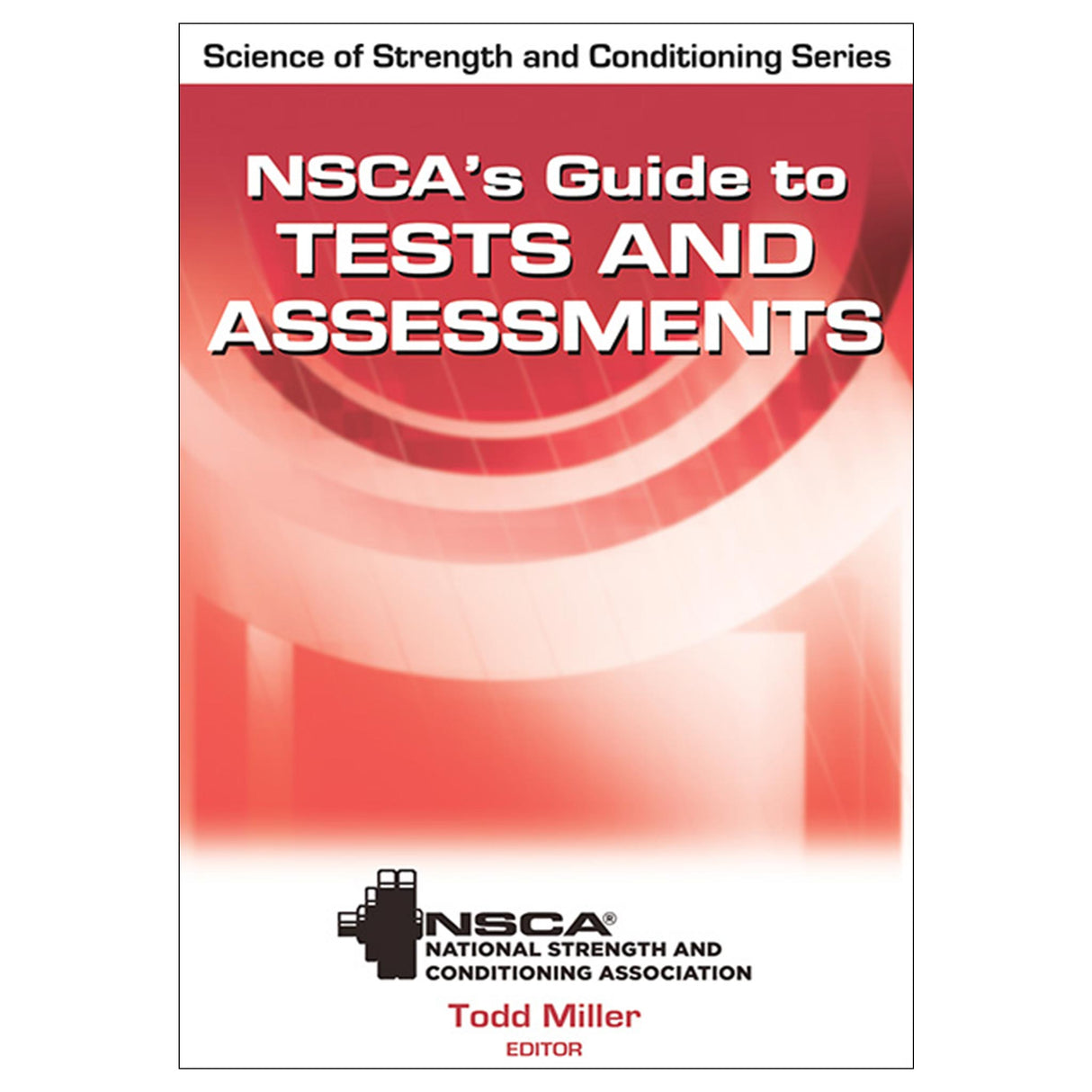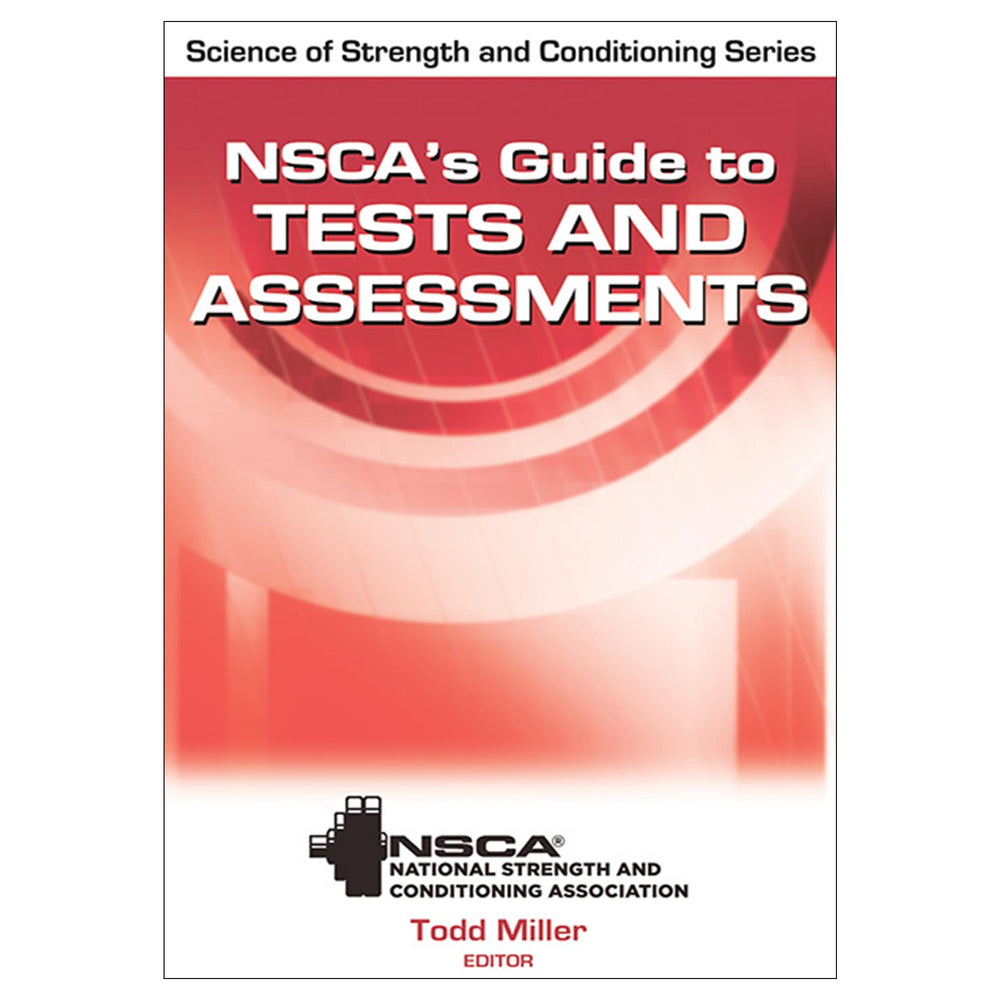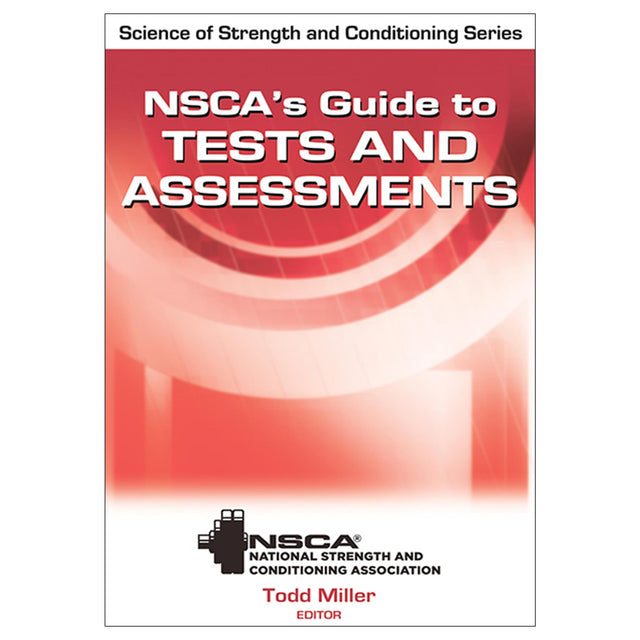NSCA's Guide to Tests and Assessments
Author: Todd A. Miller
$82.95 CAD
NSCA's Guide to Tests and Assessments offers strength and conditioning professionals a one-stop resource for the best research-supported fitness and performance measures available. Created by top experts in the National Strength and Conditioning Association (NSCA), this comprehensive text offers extensive information on which factors matter and how to evaluate them as accurately and easily as possible. Editor Todd Miller and an authoritative team of contributors have compiled an exceptional reference and valuable tool for practicing professionals and an indispensable educational resource for students.
NSCA's Guide to Tests and Assessments presents the latest research from respected scientists and practitioners in exercise testing and assessment. The text begins with an introduction to testing, data analysis, and formulating conclusions. It then features a by-chapter presentation of tests and assessments for body composition, heart rate and blood pressure, metabolic rate, aerobic power, lactate threshold, muscular strength, muscular endurance, power, speed and agility, mobility, and balance and stability. Using descriptions of multiple test options for each key fitness component, readers will learn to choose from a range of alternatives to meet the needs of their athletes, reach training objectives, choose from available equipment, and work within budgets.
Each chapter provides a summary detailing the key testing and assessment information for each fitness component, the equipment needed for performing the tests, step-by-step instructions, normative data for the tests, and multiple test options per conditioning component. Insights into the applications of testing for certain fitness components are also presented:
• The value of body composition assessments in determining health and fitness levels for competitive athletes as well as individuals across the life span
• How an understanding of 24-hour energy expenditure can be useful in structuring a complete diet and exercise plan for weight loss, gain, or maintenance
• How to select a maximal or submaximal aerobic power test that is specific to the demands of a client’s or athlete’s sport
• Discussion of the mechanical and physiological factors shown to influence the expression of muscular strength
• An examination of the relevant factors influencing power production and explosive movement capacity
• Differences between mobility and flexibility and a discussion of the acute versus chronic effects of static stretching
• Theories and concepts of balance and stability, their effects on performance, and categories of testing for balance and stability
NSCA's Guide to Tests and Assessments also includes NSCA-approved testing protocols, extensive references to current research, and applications for the testing of conditioning components. Information is presented in an accessible manner to help explain the findings of both researchers and practitioners so that readers can select the most effective and efficient approach for athlete and client assessments.
Properly conducted tests and skillful assessment of data enable fitness professionals to develop individualized training programs based on their clients’ or athletes’ physiological and functional capacities. Credible,, current, and complete, NSCA's Guide to Tests and Assessments provides a clear understanding of the test selection process, how to implement appropriate data collection, and how to analyze data to make appropriate training decisions that will help athletes and clients achieve their performance goals.
NSCA’s Guide to Tests and Assessments is part of the Science of Strength and Conditioning series. Developed with the expertise of the National Strength and Conditioning Association (NSCA), this series of texts provides the guidelines for converting scientific research into practical application. The series covers topics such as tests and assessments, program design, and nutrition.
Earn continuing education credits/units! A continuing education course and exam that uses this book is also available. It may be purchased separately or as part of a package that includes all the course materials and exam.
Audience
A reference for strength and conditioning professionals, athletic trainers, and personal trainers. Also a text and reference for students taking courses in strength and conditioning or allied fields.
Chapter 1: Tests, Data Analysis, and Conclusions
Matt Rhea, PhD, and Mark Peterson, PhD
Screening Tests
Data Evaluation and Statistical Analysis
Normalizing of Fitness Data
Tracking Data Over Time
Summary
Chapter 2: Body Composition
Nick Ratamess, PhD
Sport Performance and Body Composition
Body Composition Measurement
Measuring Height, Body Weight, and Body Mass Index
Body Fat Standards
Comparison of Body Composition Techniques
Summary
Chapter 3: Heart Rate and Blood Pressure
Dan Drury, DPE
Heart Rate Control
Exercise Intensity and Heart Rate
Sport Performance and Heart Rate
Heart Rate Measurement
Blood Pressure
Summary
Chapter 4: Metabolic Rate
Wayne Miller, PhD, EMT
Components of Energy Expenditure
Sport Performance and Metabolic Rate
Measurement of Energy Expenditure
Prediction of Energy Expenditure
Estimation of 24-hour and Physical Activity Energy Expenditure
Relevance and Applications for Metabolic Testing
Summary
Chapter 5: Aerobic Power
Jonathan Anning, PhD
Regression Equation Variables
Maximal Exercise Testing Methods
Submaximal Exercise Testing Methods
Regression Equation Calculations
Summary
Chapter 6: Lactate Threshold
Dave Morris, PhD
Energy Pathways and Lactate Metabolism
Sport Performance and Lactate Threshold
Performing a Lactate Threshold Test
Maximal Lactate Steady State
Using Lactate Threshold Data
Summary
Chapter 7: Muscular Strength
Gavin Moir, PhD
Definition of Muscular Strength
Factors Affecting Muscular Force Production
Sports Performance and Muscular Strength
Methods of Measurement
Field Tests for Muscular Strength
Predicting 1RM Values from Multiple Repetitions
Laboratory Tests for Maximal Muscular Strength
Isokinetic Strength Testing
Summary
Chapter 8: Muscular Endurance
Gavin Moir, PhD
Definition of Muscular Endurance
Field Tests for Muscular Endurance
Laboratory Tests for Muscular Endurance
Summary
Chapter 9: Power
Mark D. Peterson, PhD
Operationalizing Power
Mechanisms of Power Production and Expression
Types and Factors of Power
Sport Performance and Power
Tests for Power
Lower Body Tests
Upper Body Tests
Warm-Up and Postactivation Potentiation (PAP): A Special Consideration for Testing Power
Summary
Chapter 10: Speed and Agility
N. Travis Triplett, PhD
Speed
Agility
Sport Performance and Speed and Agility
Test Selection
Methods of Measurement
Summary
Chapter 11: Mobility
Sean P. Flanagan, PhD
Fundamental Concepts of Mobility
Sport Performance and Mobility
Mobility Testing
Range of Motion Tests
Interpretation of Results
Comparing Mobility Measurement Methods
Summary
Chapter 12: Balance and Stability
Sean P. Flanagan, PhD
Body Mechanics
Control Theory
Balance and Stability Tests
Sport Performance and Balance and Stability
Measuring Balance and Stability
Interpreting the Results
Founded in 1978, the National Strength and Conditioning Association (NSCA) is an international nonprofit educational association with members in more than 56 countries. Drawing on its vast network of members, the NSCA develops and presents the most advanced information regarding strength training and conditioning practices, injury prevention, and research findings.
Unlike any other organization, the NSCA brings together a diverse group of professionals from the sport science, athletic, allied health, and fitness industries. By working to find practical applications for new research findings in the strength and conditioning field, the association fosters the development of strength training and conditioning as a discipline and as a profession.
Todd A. Miller, PhD, is an associate professor of exercise science at the George Washington University School of Public Health and Health Services in Washington DC, where he is responsible for the development and oversight of the master's degree concentration in strength and conditioning. He has degrees in exercise physiology from Penn State and Texas A&M and currently studies the role of interactive video gaming as a means of increasing physical activity in children.
“This book takes an aggressive, holistic approach to the longstanding profession of strength and conditioning. The authors make a first-rate effort to move the profession of strength and conditioning forward into a new realm of expertise as professionals in the business of getting athletes to perform beyond their own expectations.”
-- Doody’s Book Review





